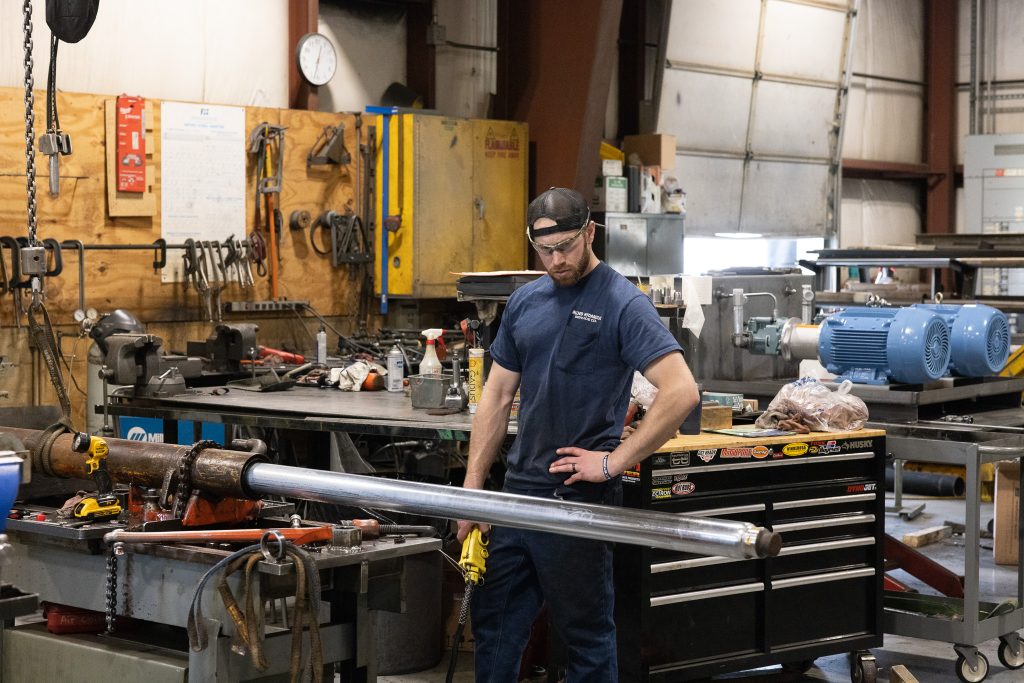At Allied Hydraulic Service Co., we provide specialized repair services for hydraulic and pneumatic cylinders, ensuring they operate efficiently and reliably. Whether you’re working with an inefficient cylinder or experiencing a devastating failure, our team can help.
We diagnose, test, and repair tie rod and welded cylinders for multiple brands, including Caterpillar, Komatsu, Terex, and Parker.

Fluid Contamination: Contaminants such as dirt, moisture, and debris can cause significant damage to cylinder components, leading to wear, corrosion, and inefficiency. Regularly cleaning and filtering the fluid is essential to prevent contamination.
Seal Failure: Seals can deteriorate over time due to wear, high temperatures, or chemical exposure, resulting in leaks and reduced performance. Ensuring proper seal maintenance and replacement is crucial.
Overloading and Misalignment: Excessive side loading, improper mounting, and misalignment can cause uneven wear and stress on the cylinder, leading to premature failure. Proper installation and regular inspections can mitigate these issues.
Improper Maintenance: Lack of regular maintenance, including lubrication and inspection, can accelerate wear and lead to system failures. A proactive maintenance approach is vital for cylinder longevity.
Environmental Factors: Exposure to extreme temperatures, chemicals, or harsh environments can degrade cylinder materials and components, leading to corrosion and failure.
Not all cylinder issues offer warning signs. Sudden failures require emergency repair services. Our team of skilled technicians can rapidly respond to your emergency situation to minimize downtime and prevent further damage to your equipment.
We start with a thorough inspection to identify the root cause of the failure, checking for fluid contamination, seal integrity, and signs of wear or damage.
The cylinder is carefully disassembled to access and inspect internal parts, ensuring all potential issues are identified.
Contaminated fluid is removed, and the cylinder is cleaned and flushed to eliminate debris. Fresh fluid is added to maintain system integrity.
Worn or damaged parts, such as seals, gaskets, or rods, are replaced with high-quality components to restore the cylinder’s performance. Rods are polished or replaced to remove imperfections, and all tubes are honed to assure concentricity and finish.
The cylinder is reassembled and rigorously tested under operating conditions to ensure it functions correctly. This includes dynamic pressure testing on our state-of-the-art test stand. All units are checked for proper GPM, PSI, external leakage, and torque output.
After successful testing, we perform final check and the units are fitted with cap plugs and painted.
Yes, both hydraulic and pneumatic cylinders can often be repaired. Common repairs include replacing worn seals, fixing leaks, and addressing issues with the piston or rod
To stop a cylinder from leaking, identify the source of the leak, usually around seals or gaskets, and replace them. Ensure all connections are tight and the cylinder is properly aligned.
Yes, a bent rod can often be straightened, but severe bends may require replacement to ensure proper function.
Regularly inspecting and maintaining the cylinder, using the correct type and grade of fluid, keeping the system clean, and ensuring proper installation and alignment are key to preventing failures
Signs include complex damage, lack of proper tools, safety concerns, and recurring issues. If these signs are present, professional repair is recommended to ensure safety and longevity